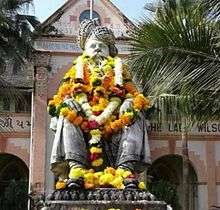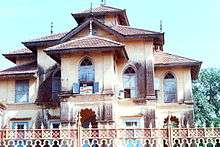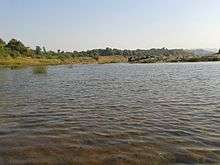Dharampur, Gujarat
| Dharampur | |
|---|---|
| village | |
 Dharampur Location in Gujarat, India  Dharampur Dharampur (India) | |
| Coordinates: 20°32′N 73°11′E / 20.53°N 73.18°ECoordinates: 20°32′N 73°11′E / 20.53°N 73.18°E | |
| Country |
|
| State | Gujarat |
| District | Valsad |
| Elevation | 74 m (243 ft) |
| Population (2001) | |
| • Total | 19,932 |
| Languages | |
| • Official | Gujarati, Hindi |
| Time zone | UTC+5:30 (IST) |
| Vehicle registration | GJ 15 |
| Website |
gujaratindia |
Dharampur is a city and a municipality in Valsad district in the state of Gujarat, India.
Geography
Dharampur is located at 20°32′N 73°11′E / 20.53°N 73.18°E.[1] It has an average elevation of 74 metres (242 feet). Dharampur is the small and beautiful town situated east of Valsad. Dharampur is situated on the banks of the Swargavahini River and is surrounded by the Sahyadri or Western Ghats range on the east, west and south. Due to its location, the town enjoys a very pleasant climate throughout the year. Dharampur is called cherrapunji of Gujarat receiving highest rainfall in the state.
History
Dharampur was created in Dharampur, situated in south Gujarat, was a capital of the former princely State of Dharampur. It was founded 1262 as Ramnagar, and the first king of this state was Maharana Ramsinh. The present day Dharampur dates back to 1764 and was founded by King Dharmdevji. The descendants of the Sisodia Rajputs of Chittor ruled in the history of Dharampur. After the fall of the Delhi Sultanate in south Gujarat, the State of Dharampur flourished and gained a very significant and powerful position by controlling at least seven strategic forts in the region.

The Dharampur State was surrounded by the Muslim states of Khandesh, Ahmednagar and the Sultanate of Gujarat, but because of its strategic importance, was never attacked by the Muslims. Even the 'Parsis' found political patronage under the Dharampur kings. The Dharampur kings had cordial relations with Portuguese traders from the south Gujarat ports and used to receive tax revenue from them. Development in Phases the City of Dharampur had two major phases of development the first in the late 18th century, when the Rana undertook the construction of Raj Mahal, public buildings, stepwells and temples. The second phase was in the late 19th century, when as a part of the Queen Victoria Golden Jubilee celebrations, the Anglo Vernacular School, jail and hospitals was constructed. King Mohandevji (1891-1921) studied at Rajkumar College, Rajkot and introduced many reforms. Under his patronage, Mohan Vilas Palace, Pramod Bhavan, State guesthouse and several temples were constructed. Roads, water tanks and bridges were built to improve the infrastructure of the state. King Vijaydevji, on his accession to kingdom in 1921, constructed a museum and dedicated it to Lady Wilson. Vijaydevji undertook extensive travelling to collect rare and genuine art objects for display in museum. He was a great patron of art and music and a well-known musician, with equal command over both Indian and western classical music. He wrote a treatise on music 'Sangeet Bhav' in six volumes, with Gujarati, Hindi, English and French notations. He was also fond of hunting and constructed a hunting lodge at Audha and residences at Wilson Hills as summer retreats. The town has a very beautiful entrance gate (Rajya Rohan Gate) done in European style with life-size statues in Greek style adorning the top. Bandstand and gymkhana building are located, near the gate. In the old days, the State Band used to play music in the evenings for the citizens of Dharampur, at the BandStand.

In 1900, Shrimad Rajchandra had consecrated the soil of Dharampur for about 35 days (from chaitra sud ekam to vaishakh sud pancham, V.S. 1956). He had spent much of this time in solitude, at the crematorium and in the surrounding jungles, immersed in spiritual bliss. Dharampur today is home to the international headquarters of the Shrimad Rajchandra Mission founded by Rakesh Jhaveri. The mission's international headquarters is located on the hillock of Mohangadh.
On 10 June 1948, the Raja of Dharampur acceded to the Indian Union, and Dharampur state became part of Bombay State.[2]

Tribal Belt

Spread across the lush green region of South Gujarat Tribal Belt said to be Kashmir of Gujarat. Interaction with fun and loving Tribes of Kholcha, Bhel, Nayaka, Koknas, Vedch, Gamits, Warlis, Chaudaris etc. is lifetime experience. They live in Area which is eight 'Hottest Biodiversity Hotspots' in world as defined by UNESCO. Dharampur and is surrounding witness habitat of Tribal Peoples of Southern Tribal Belt. Tribal people of the region were very poor before independence but due right government policies and social work done by some of the prominent gandhian followers like Premshankar Bhatt, Urmillaben Bhatt, Kalanji Kaka who started Tribal Ashram under name of Dakshin Gujarat Adivasi Sevamandal' gave major contribution in educating tribal kids since 1948.
It was located in Dharampur city in Gujarat state, India.[3][4] Today Dharampur is a small, peaceful town with a royal heritage that has become a tourist destination. It is located on Vansada-Valsad(N.H. 56) Highway, with Waghai just 60km away. The town is on the banks of Swargavahini river at the foothills of the Sahyadri mountain range. Tourist sites include the Japanese Gardens, Laxminarayan Temple, Wilson Hills, Gujarat and the Lady Wilson Museum.[5]
References
- ↑ Falling Rain Genomics, Inc - Dharampur
- ↑ "Dharampur". Royal Family of India. Accessed 13 September 2017.
- ↑ Dharampur
- ↑ Dharampur State
- ↑ GJ tourism